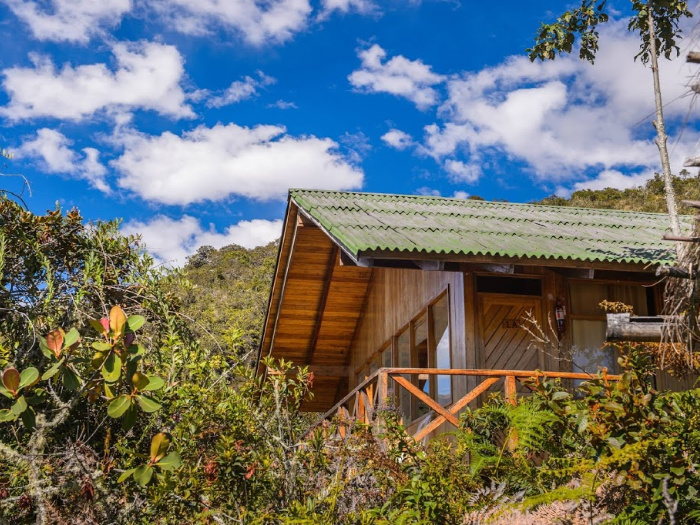Our biological stations in Peru and Bolivia offer a unique opportunity to explore and discover the outstanding biological and cultural diversity of this region. Spanning an altitudinal gradient from 820 to 9,880 feet, our stations are active centers of learning and discovery, attracting researchers, university courses, volunteers, and visitors from around the world.
These premier stations provide Amazon Conservation an on-the-ground presence where we conduct our conservation work, and where the work of researchers contributes to the global scientific community, raises awareness about tropical ecology and conservation, and informs our conservation decisions.
In 2005, Amazon Conservation created Peru’s only permanent field research station focused on cloud forest ecology and management.
This 1,450-acre research center, called Wayqecha (meaning “brother” in the local language of Quechua), sits at 3,000 meters above sea level. The station is located in the Kosñipata Valley in the department of Cusco, in southeastern Peru, where it serves as a buffer along the southern edge of Manu National Park.
Wayqecha is one of the world’s best sites to explore the lush cloud forest ecosystem.
A constant supply of moisture supports a remarkable diversity of plants, which in turn supports thriving populations of birds, amphibians, orchids, and mammals. Some of its best features include an orchid trail and a state-of-the-art canopy walkway, the first of its kind in Peru, where you can observe the forest from 65 to 144 feet above.

Located in the Andean foothills, Villa Carmen stands on over 7,500 acres of land within the spectacular Manu Biosphere Reserve in Southern Peru.
Spanning an elevational gradient of 1,700 to almost 4,000 feet above sea level, Villa Carmen hosts an incredible array of species found in a variety of habitats, ranging from cloud forest to montane and lowland rainforest.
The station neighbors several indigenous Wachiperi and Machiguenga communities as well as the Wachiperi Haramba Queros Conservation Concession, established with assistance from Amazon Conservation as the first conservation concession in Peru run by an indigenous community.
Villa Carmen promotes sustainable agroforestry and aquaculture, host educational programs, and further incorporate local communities into conservation efforts.
The station supports a wide variety of habitats including old-growth rainforest, lower mountain forest, secondary forests, streams, rivers, waterfalls, and highly diverse flora and fauna.
Dotted with sparkling streams, rivers, and waterfalls, Villa Carmen is an ideal place to discover the beauty and bounty of the Amazon.

Los Amigos is located in lowland Amazonian forest at the base of Peru’s southern Andes.
The station sits at the tip of a peninsula on a high terrace between the Madre de Dios and Los Amigos Rivers and provides easy access to various forest types and aquatic habitats. The Los Amigos station was established in 2000, on the conviction that the greatest forest on earth deserves the best research centers in the world.
Los Amigos is a leading training site for young scientists and conservationists.
In addition to muddy-boots field experience in the 360,000-acre Los Amigos Conservation Concession, adjoining our 1,119-acre biological station, these young scientists benefit from regular presentations by visiting researchers, involvement with the station’s long-term ecological monitoring program, specialized training as part of field courses, access to a large scientific library, and immersion in a vibrant scientific community.

As a direct result of our efforts, the Bolivian government declared a protected area that encompasses the Tahuamanu Biological Station.
This 7,550-acre lowland forest research station is managed directly by the Amazonian University of Pando with our support. We have also helped the University expand the station’s area to cover another 2,300 acres through a land purchase – now protecting the habitat of 11 species of primates.

From Nashville to the Amazon: Linking Business, Sustainability, and Ecosystems Business supporters are one of Amazon Conservation’s favorite avenues to raise awareness and support for our work because of their unhindered desire to give back to the planet. Whether directly donating to our work, promoting awareness of the Amazon’s importance to their clients, running campaigns […]
In January 2022, we launched the Observatory of Amazonian Fruits and Climate Change in the Amazonian department of Pando, Bolivia. The Observatory is the culmination of a 10-month project in collaboration with local Bolivian organizations such as the Inter-Institutional Platform for Articulation of Productive Complexes of Amazonian Fruits (PICFA) and the Departamental Federation of Açai […]
Thanks to our strategic collaboration with organizations Fundación EcoCiencia in Ecuador and SOS Orinoco in Venezuela, we saw two great successes with reports from our Monitoring of the Andean Amazon Program (MAAP), that resulted in on-the-ground action taken against illegal mining in the Amazon. Together with EcoCiencia, we published a report revealing the alarming illegal […]